NVIDIA Refreshes Quadro Lineup, Launches 5 New Quadro Cards
by Ryan Smith on August 12, 2014 10:45 AM EST
Continuing today’s spate of professional graphics announcements, along with AMD’s refresh of their FirePro lineup NVIDIA is announcing that they are undertaking their own refresh of their Quadro lineup. Being announced today and shipping in September are 5 new Quadro cards that will come just short of a top-to-bottom refresh of the Quadro lineup.
With the exception of NVIDIA’s much more recently introduced Quadro K6000 – which will continue its reign as NVIDIA’s most powerful professional GPU – NVIDIA’s Quadro refresh comes as the bulk of the current Quadro K5000 family approaches 2 years old. At the point NVIDIA is looking to offer an across-the-board boost to their Quadro lineup, to increase performance and memory capacity at every tier. As a result this refresh will involve replacing NVIDIA’s Quadro cards with newer models based on larger and more powerful Kepler and Maxwell GPUs, and released as the Quadro Kx200 series. All told, NVIDIA is shooting for an average performance improvement of 40%, on top of any benefits from the larger memory amounts.
| NVIDIA Quadro Refesh Specification Comparison | |||||||
| Quadro K5200 | Quadro K4200 | Quadro K2200 | Quadro K620 | Quadro K420 | |||
| CUDA Cores | 2304 | 1344 | 640 | 384 | 192 | ||
| Core Clock | 650MHz | 780MHz | 1GHz | 1GHz | 780MHz | ||
| Memory Clock | 6GHz GDDR5 | 5.4GHz GDDR5 | 5GHz GDDR5 | 1.8GHz DDR3 | 1.8GHz DDR3 | ||
| Memory Bus Width | 256-bit | 256-bit | 128-bit | 128-bit | 128-bit | ||
| VRAM | 8GB | 4GB | 4GB | 2GB | 1GB | ||
| Double Precision | ? | 1/24 | 1/32 | 1/32 | 1/24 | ||
| TDP | 150W | 105W | 68W | 45W | 41W | ||
| GPU | GK110 | GK104 | GM107 | GM107 | GK107? | ||
| Architecture | Kepler | Kepler | Maxwell | Maxwell | Kepler | ||
| Displays Supported (Outputs) | 4 (4) | 4 (3) | 4 (3) | 4 (2) | 4 (2) | ||
We’ll start things off with the Quadro K5200, NVIDIA’s new second-tier Quadro card. Based on a cut down version of NVIDIA’s GK110 GPU, the K5200 is a very significant upgrade to the K5000 thanks to the high performance and unique features found in GK110. The combination of which elevates the K5200 much closer to the K6000 than the K5000 it replaces.
The K5200 ships with 12 SMXes (2304 CUDA cores) enabled and utilizes a 256-bit memory bus, making this the first NVIDIA GK110 product we’ve seen ship without the full 384-bit memory bus. NVIDIA has put the GPU clockspeed at 650MHz while the memory clock stands at 6GHz. Meanwhile the card has the second largest memory capacity of the Quadro family, doubling K5000’s 4GB of VRAM for a total of 8GB.
Compared to the K5000, K5200 offers an increase in shader/compute throughput of 36%, and a smaller 11% increase in memory bandwidth. More significant however are GK110’s general enhancements, which elevate K5200 beyond K5000. Whereas K5000 and its GK104 GPU made for a strong graphics card, it was a relatively weak compute card, a weakness that GK110 resolved. As a result K5200 should be similar to K6000 in that it’s a well-balanced fit for mixed graphics/compute workloads, and the ECC memory support means that it offers an additional degree of reliability not found on the K5000.
As is usually the case in rolling out a refresh wave of cards based on existing GPUs, because performance has gone up power consumption has as well. NVIDIA has clamped K5200 at 150W (important for workstation compatibility), which is much lower than the full-fledged K6000 but is 28W more than the K5000. None the less the performance gains should easily outstrip the power consumption increase.
Meanwhile display connectivity remains unchanged from the K5000 and K6000. NVIDIA’s standard Quadro configuration is a DL-DVI-I port, a DL-DVI-D port, and a pair of full size DisplayPorts, with the card able to drive up to 4 displays in total through a combination of those ports and MST over DisplayPort.
NVIDIA’s second new Quadro card is the K4200. Replacing the GK106 based K4000, the K4200 sees NVIDIA’s venerable GK104 GPU find a new home as NVIDIA’s third-tier Quadro card. Unlike K5200, K4200’s GPU shift doesn’t come with any kind of dramatic change in functionality, so while it will be an all-around more powerful card than the previous K4000, it’s still going to be primarily geared towards graphics like the K4000 and K5000 before it.
For the K4200 NVIDIA is using a cut down version of GK104 to reach their performance and power targets. Comprised of 7 active SMXes (1344 CUDA cores), the K4200 is paired with 4GB of VRAM. Clockspeeds stand at 780MHz for the GPU and 5.4GHz for the VRAM.
On a relative basis the K4200 will see some of the greatest performance gains of this wave of refreshes. Its 2.1 TFLOPS of compute/shader performance blasts past K4000 by 75%, and memory bandwidth has been increased by 29%. However the 4GB of VRAM makes for a smaller increase in VRAM than the doubling most other Quadro cards are seeing. Otherwise power consumption is once again up slightly, rising from 80W to 105W in exchange for the more powerful GK104 GPU.
Finally, as was the case with K5200 display connectivity remains unchanged. Since the K4200 is a single slot card like K4000 before it, this means NVIDIA uses a single DL-DVI-I port along with a pair of full size DisplayPorts. Like other Kepler products the card can drive up to 4 displays, though doing this will require a DisplayPort MST hub to get enough outputs. Which on that note, users looking to pair this card with multiple monitors will be pleased to find that Quadro Sync is supported in the K4200 for the first time, being limited to the K5000 and higher previously.
In NVIDIA’s refreshed Quadro lineup, the K4200 will primarily serve as the company’s highest-end single-slot offering. As with other GK10x based GPUs compute performance is not its strongest suit, while for graphics workloads such as CAD and modeling it should offer a nice balance of performance and price.
Moving on, NVIDIA’s third Quadro refresh card is the K2200. This replaces the GK107 based K2000 and marks the first Quadro product to utilize one of NVIDIA’s newest generation Maxwell GPUs, tapping NVIDIA’s GM107 GPU. The use of Maxwell on a Quadro K part makes for an amusing juxtaposition, though the architectural similarities between Maxwell and Kepler mean that there isn’t a meaningful feature difference despite the generation gap.
As was the case with NVIDIA’s consumer desktop GM107 cards, NVIDIA is aiming to produce an especially potent sub-75W card for K2200. Here NVIDIA uses a fully enabled GM107 GPU – all 5 SMMs (640 CUDA cores) are enabled – and it’s paired with 4GB of VRAM on a 128-bit bus. Meanwhile based on NVIDIA’s performance figures the GPU clockspeed should be just north of 1GHz while the memory clock stands at 5GHz.
Since the K2200 is replacing a GK107 based card, the performance gains compared to the outgoing K2000 should be significant. On the consumer desktop side we’ve seen GM107 products come close to doubling GK107 parts, and we’re expecting much the same here. K2200’s 1.3 TFLOPS of single precision compute/shader performance is 78% higher than K2000’s, which means that K2200 should handily outperform its predecessor. Otherwise the 4GB of VRAM is a full doubling over the K2000’s smaller VRAM pool, greatly increasing the size of the workloads K2200 can handle.
Meanwhile display connectivity is identical to the new K4200 and the outgoing K2000. The K2200 can drive up to 4 displays by utilizing a mix of its DL-DVI port, two DisplayPorts, and a DisplayPort MST hub.
In NVIDIA’s new Quadro lineup the K2200 will serve as their most powerful sub-75W card. As we’ve seen in other NVIDIA Maxwell products, this is an area the underlying GM107 excels at.
NVIDIA’s fourth Quadro card is the K620. This is another Maxwell card, and while NVIDIA doesn’t specify the GPU we believe it to be based on GM107 (and not GM108) due to the presence of a 128-bit memory bus. K620 replaces the GK108 based K600, and should offer substantial performance gains similar to what is happening with the K2200.
K620’s GM107 GPU features 3 SMMs (384 CUDA cores) enabled, and it is pair with 2GB of DDR3 operating on a 128-bit memory bus. Like K2200 the GPU clockspeed appears to be a bit over 1GHz, and meanwhile the memory clockspeed stands at 1.8GHz.
Compared to the K600 overall performance should be significantly improved. Though it’s worth pointing out that since memory bandwidth is identical to NVIDIA’s previous generation card, in memory bandwidth bound scenarios the K620 may not pull ahead by too much. None the less the memory pool has been doubled from 1GB to 2GB, so in memory capacity constrained situations the K620 should fare much better. Power consumption is just slightly higher this time, at 45W versus K600’s 41W.
As this is a 3 digit Quadro product, NVIDIA considers this an entry level card and it is configured accordingly. A single DL-DVI port and a single full size DisplayPort are the K620’s output options, with an MST hub being required to attach additional monitors to make full use of its ability to drive 4 displays. By going with this configuration however NVIDIA is able to offer the K620 in a low profile configuration, making it suitable for smaller workstations that can’t accept full profile cards.
Finally, NVIDIA’s last new Quadro card is the K420. Dropping back to a Kepler GPU (likely GK107), it replaces the Quadro 410. From a performance perspective this card won’t see much of a change – the number of CUDA cores is constant at 192 – but memory bandwidth has been doubled alongside the total VRAM pool, which is now 1GB.
Like K620, K420 can drive a total of 4 displays, while the physical display connectors are composed of a single DL-DVI port and a single full size DisplayPort. This low profile card draws 41W, the same as the outgoing 410.
With all but 1 of these cards receiving a doubled VRAM pool and significantly improved performance, NVIDIA expects that these cards should be well suited to accommodating the larger datasets that newer applications use, especially in the increasingly important subject of 4K video. Coupled with NVIDIA’s existing investment in software – both ISVs and their own cloud technology ecosystem – NVIDIA expects to remain ahead of the curve on functionality and reliability.
Wrapping things up, NVIDIA tells us that the Quadro refresh cards will be shipping in September. In the meantime we’ll be reviewing some of these cards later this month, so stay tuned.

















24 Comments
View All Comments
ArthurG - Tuesday, August 12, 2014 - link
no article on Nvidia Denver ?Morawka - Tuesday, August 12, 2014 - link
cuz it's faster than apple's a7 sillyextide - Wednesday, August 13, 2014 - link
No, because it is vaporwareGunbuster - Tuesday, August 12, 2014 - link
Fantastic plastic! I know these get hidden in workstations but do they have to sport dollar store plastic shrouds? I mean the K5200 is going to be a $2000 something card right?TiGr1982 - Tuesday, August 12, 2014 - link
These are professional cards for doing work, not for bragging. Professionals don't care how they look, but only how they work.TETRONG - Tuesday, August 12, 2014 - link
Can somebody clue me in? Why is it that GPU's all seem to be backing off bigger memory buses?256 bit...isn't that simply an artificial constraint?
Really curious about this - Shouldn't 512 and higher be considered the norm at this time, especially for professional usage?
akdj - Tuesday, August 12, 2014 - link
With memory bandwidth @ 288GB/s and 12GB RAM clocked @ 6GHz, 256mb is plenty. Quite a lot actually. Almost 175 3.5" floppies guiding a three billion opposing traffic system. They're good at what they do;). I'm not so sure it needs to be larger as 256 is actually quite massive. For a memory bus. These are going to be incredible cards.RussianSensation - Tuesday, August 12, 2014 - link
288GB/sec on K6000 is achieved with a 384-bit bus, not 256-bit. Your numbers aren't lining up.Morawka - Tuesday, August 12, 2014 - link
the smaller the memory bus, the smaller the DIE is. The more you harvest from a wafer.Companies are going to small bus, big seats approach by putting a lot of cache to offset.
TLDR: to increase profit margins
MrSpadge - Wednesday, August 13, 2014 - link
"the smaller the memory bus, the smaller the DIE is"I think he was referring more to the fact that K5200 uses an expensive GK110 chip with 384 bit memory bus, yet artificially limits its performance by only using 256 of these bits. The wider memory bus could give nVidia "free" performance (only slightly more complex PCB) from the same chip, or similar performance from a chip running a more power efficient setting.